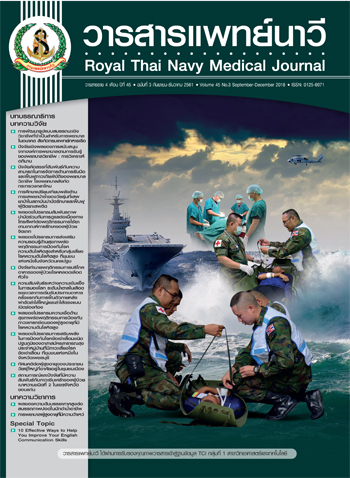The Effects of Health Literacy Enhancement Program on Hypertensive Prevention Behavior of Pre-hypertension Risk Group at a Community in Nakhon Pathom Province
Main Article Content
Abstract
การวิจัยครั้งนี้เป็นการวิจัยกึ่งทดลองแบบสองกลุ่มวัดผลก่อนหลัง มีวัตถุประสงค์เพื่อศึกษาผลของโปรแกรมการส่งเสริมความรอบรู้ด้านสุขภาพในการป้องกันโรคความดันโลหิตสูง กลุ่มตัวอย่าง คือ ประชาชนวัยผู้ใหญ่อายุ 35 - 59 ปี ที่มีความเสี่ยงต่อโรคความดันโลหิตสูงในจังหวัดนครปฐม คัดเลือกแบบเจาะจง จำนวน 60 คน แบ่งเป็นกลุ่มทดลองและกลุ่มควบคุม กลุ่มละ 30 คน กลุ่มทดลองได้รับโปรแกรมการส่งเสริมความรอบรู้ด้านสุขภาพซึ่งพัฒนาจากแนวคิดความรอบรู้ด้านสุขภาพของ Nutbeam กลุ่มควบคุมได้รับการคัดกรองโรคความดันโลหิตสูงตามปกติ เครื่องมือที่ใช้ในการทดลองครั้งนี้ ได้แก่ โปรแกรมการส่งเสริมความรอบรู้ด้านสุขภาพในการป้องกันโรคความดันโลหิตสูง โดยใช้การเรียนรู้แบบมีส่วนร่วมผ่านสื่อรูปแบบต่างๆ และแอปพลิเคชันไลน์ เครื่องมือที่ใช้ในการเก็บรวบรวมข้อมูล ได้แก่ แบบสอบถามข้อมูลส่วนบุคคล แบบประเมินความรอบรู้ด้านสุขภาพและพฤติกรรมการป้องกันโรคความดันโลหิตสูง วิเคราะห์ข้อมูลโดยใช้สถิติเชิงพรรณนาและสถิติที
ผลการวิจัย พบว่า ภายหลังได้รับโปรแกรมการส่งเสริมความรอบรู้ด้านสุขภาพ กลุ่มทดลองมีค่าคะแนนเฉลี่ยความรอบรู้ด้านสุขภาพและพฤติกรรมการป้องกันโรคความดันโลหิตสูง สูงกว่าก่อนได้รับโปรแกรมฯ และสูงกว่ากลุ่มควบคุม อย่างมีนัยสำคัญทางสถิติ นอกจากนี้ยังมีค่าเฉลี่ยระดับความดันโลหิตซิสโตลิกและไดแอสโตลิกต่ำกว่าก่อนได้รับโปรแกรม อย่างมีนัยสำคัญทางสถิติ อย่างไรก็ตามเมื่อเปรียบเทียบระหว่างกลุ่มทดลองและกลุ่มควบคุม พบว่า ค่าเฉลี่ยระดับความดันโลหิตซิสโตลิกไม่แตกต่างกัน แต่ค่าเฉลี่ยระดับความดันไดแอสโตลิกต่ำกว่า อย่างมีนัยสำคัญทางสถิติ ผลจากการวิจัยครั้งนี้ แสดงให้เห็นว่าโปรแกรมการส่งเสริมความรอบรู้ด้านสุขภาพช่วยให้กลุ่มเสี่ยงมีความรอบรู้ด้านสุขภาพ มีพฤติกรรมการป้องกันโรคเพิ่มขึ้น และระดับความดันโลหิตลดลง โดยเฉพาะการเรียนรู้แบบมีส่วนร่วมและแอปพลิเคชันไลน์ ช่วยให้กลุ่มตัวอย่างเกิดการเรียนรู้ได้ดียิ่งขึ้น ดังนั้นจึงมีข้อเสนอแนะว่าควรนำโปรแกรมการส่งเสริมความรอบรู้ด้านสุขภาพไปใช้ในการส่งเสริมพฤติกรรมการป้องกันโรคความดันโลหิตสูง และโรคไม่ติดต่อเรื้อรังอื่นในชุมชน
Article Details

This work is licensed under a Creative Commons Attribution-NonCommercial-NoDerivatives 4.0 International License.
References
2. World Health Organization. A global brief on hypertension world health day 2013. [Internet]. [cite 2016 September 10]. Available from: https://ish- world.com/global _brief_hypertension.
3. กระทรวงสาธารณสุข สำนักโรคไม่ติดต่อ กรมควบคุมโรค. รายงานประจำปี 2558. กรุงเทพมหานคร: สำนักงานกิจการโรงพิมพ์องค์การสงเคราะห์ทหารผ่านศึกในพระบรมราชูปถัมภ์; 2559.
4. กระทรวงสาธารณสุข กรมสนับสนุนบริการสุขภาพ กองสุขศึกษา. รายงานสถานการณ์พฤติกรรมสุขภาพของประชากรอายุ 15 ปีขึ้นไป พ.ศ. 2558. [อินเทอร์เน็ต]. [เข้าถึงเมื่อ 25 พฤษภาคม 2559]. แหล่งที่มา: https://164.115.22.119/.
5. Cooney N, editor. Literature review: the current situation and care model of non-communicable diseases. Nonthaburi: Art Qualified; 2014. (in Thai).
6. National High Blood Pressure Education Program. Complete report: the seventh report of the joint national committee on prevention, detection, evaluation and treatment of high blood pressure. [Internet]. [cited 2016 May 25]. Available from: https://www.nhlbi.nih.gov/files/docs/guidelines/jnc7full.pdf.
7. Taggart J, Williams A, Dennis S, Newall A, Shortus T, Zwar N, et al. A systematic review of interventions in primary care to improve health literacy for chronic disease behavioral risk factors. BMC Fam Pract 2012 Jun 1;13:49.
8. Nutbeam D. Health literacy as a public health goal: a challenge for contemporary health education and community strategies into the 21st century. Health Promotion International 2000;15(3):259-67.
9. Nutbeam D. The evolving concept of health literacy. Soc Sci Med 2008;67(12):2072-8.
10. Cho YI, Lee SY, Arozullah AM, Crittenden KS. Effects of health literacy on health status and health service utilization among the eldery. Soc Sci Med 2008;66(8):1809-16.
11. von Wagner C, Knight k, Steptoe A, Wardle J. Functional health literacy and health promoting behavior in a national sample of British adults. J Epidemiol Community Health 2007;61(12):1086-90.
12. Gladdar SF, Valerio M.A, Garcia CM, Hansen L. Adolescent health literacy: the importance of credible sources for online health information. J Sch Health 2012;82(1):28-36.
13. McNaughton CD, Kripalani S, Cawthon C, Mion LC, Wallston KA, Roumie, CL. Association of health literacy with elevated blood pressure: a cohort study of hospitalized patients. Med Care 2014;52(4):346-53.
14. World Health Organization. Health literacy and health promotion: definitions, concepts and examples in the Eastern Mediterranean Region. Individual empowerment conference working document. [Internet]. [cited 2016 May 25]. Available from: https://www.dors.it/documentazione/testo/201409/02_2009_OMS%20Nairobi_Health%20Literacy.pdf.
15. กองสุขศึกษา กรมสนับสนุนบริการสุขภาพ กระทรวงสาธารณสุข. การศึกษาสถานการณ์ความรอบรู้ด้านสุขภาพและพฤติกรรมสุขภาพของกลุ่มเสี่ยงโรคเบาหวาน/ความดันโลหิตสูง ปีงบประมาณ 2556. นนทบุรี: กองสุขศึกษา กรมสนับสนุนบริการสุขภาพ กระทรวงสาธารณสุข; 2556.
16. Choeisuwan V, Tansantawee A, et al. Selected factors related to health literacy of nursing students in Royal Thai Navy College of Nursing. Royal Thai Navy Medical Journal 2018;45(2):250-66. (in Thai).
17. Poomthavorn P, Nimit-Arnun N, Roojanavech S. The effect of health literacy promoting program for overweight primary school students. Chonburi Hospital Journal 2017;42(2):171-80. (in Thai).
18. Prompukdee S, Boonchuaythanasit K, Kainakha P. Effectiveness of health education program using participatory learning process for health literacy development on physical violent prevention of secondary school students of Saraburi primary educational service area office 2. Kasetsart Education Review 2017;32(2):144-50. (in Thai).
19. Puttapunyo S, Toontom N, Putthanachote N. Effectiveness of a health behavior development program on health literacy, weight loss behavior and weight of overweight personnel in Roi Et Hospital, Mueang District, Roi Et Province, Thailand. Journal of Nursing and Education 2016;9(4):42-59. (in Thai).
20. Sarakshetrin A, Chantra R, Kwanshom R, Ruangdoung L. The effects of using health behavior changing program (food, exercise, emotion, smoking, and alcohol cessation) among village health volunteers at Klongchanak, Muang District, Suratthani Province. The Southern College Network Journal of Nursing and Public Health 2017;4(1):253-64. (in Thai).
21. Thiangtham W, Powwattana A, Pongsomboon O. Primary hypertension prevention program for high risk population in a community, Nakornpathom Province. Journal of Nursing Science Chulalongkorn University 2010;22(1-3):11-28. (in Thai).
22. Samnak N, Eukuyi M, Boonrod T, Somrak K. Modification of health behavior in a group of patients with pre-hypertension at the Pakphanang Distric, Nakorn Si Thammarat Province. Journal for Public Health Research 2011;4(2):21-8. (in Thai).
23. Hirungerd S, Hornboonherm P, Sitipakorn S. The effects of behavioral modification program on knowledge, self-care behavior and blood pressure level in prehypertension group, Kaengkhro Hospital Chaiyaphum Province. Journal of Nurses Association of Thailand North-Eastern Division 2013;31(4):97-104. (in Thai).
24. Saengde S, Limtragool P. Guidelines to promote health for pre-hypertension in community at Suratthani Province. Journal of Nursing Science & Health 2012;35(1):39-47. (in Thai).
25. Kaewsomboon T. Participatory learning strategy to promote health literacy of pre-invasive cervical carcinoma patient. [Master’ s Thesis, Faculty of Public Health]. Mahidol University; 2008. (in Thai).
26. Phunsuwan N, Glangkarn S, Tewthong K. Effectiveness of change management health beliefs and health behaviors self risk essential hypertension disease at Kokmamaung Sub District, Pakham District, Buriram Province. Thaksin J 2015;18(2):70-8. (in Thai).

